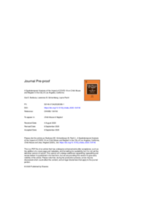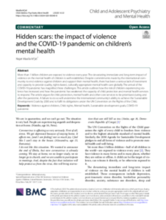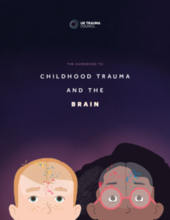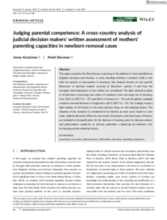Displaying 121 - 130 of 1070
The purpose of this study was to provide unique insights into the spatial and temporal distribution of child abuse and neglect (CAN) in relation to COVID-19 outcomes and identify areas where CAN has increased or decreased during the pandemic.
This discussion article describes a Child and Adolescent Mental Health Service (CAMHS) in the United Kingdom developed to meet the mental health needs of children and young people particularly those vulnerable children and young people at risk of actual or potential harm through child abuse and neglect, but may not be therapy ready.
This article outlines how the risk of children experiencing violence has increased and how the pandemic has weakened the capacity of child protection and mental health services to respond.
This study’s objective was (1) to investigate if having parent(s) born outside of Europe has an additional effect on the risk of entry into out-of-home care (OHC) in cases of alleged parental physical violence against children, and (2) to discuss potential empirical support for the risk model and the bias model for explaining the over-representation.
The RIC (Risk Indication in Child sexual abuse) and its screening version (RIC:SV) are actuarial risk assessment instruments, developed at the Austrian Federal Evaluation Centre for Violent and Sexual Offenders and designed for child protection services to assess the likelihood of sexual recidivism in male contact child sexual abusers who still or again live within a family including children.
This report is one in a series presenting findings from Save the Children's Global COVID-19 Research Study. The results presented here focus on the implications for Child Protection issues.
This resource is designed to help professionals and carers understand the latest neuroscience research on childhood abuse and neglect, with insights and advice from clinicians, teachers, and social workers on how to put your learning into practice.
This study examines an unexplored consequence of COVID-19 school closures: the broken link between child maltreatment victims and the number one source of reported maltreatment allegations—school personnel.
This paper examines the discretionary reasoning of the judiciary in three jurisdictions, England, Germany and Norway, in cases deciding whether a newborn child is safe with her parents or intervention is necessary.
Researchers are increasingly using self-report measures of physical, psychological, and sexual violence and neglect for population-based surveys. The current gold-standard measure, the 45-item ISPCAN Child Abuse Screening Tool has been used across the world. This study assesses its adequacy for measuring abuse across countries.





